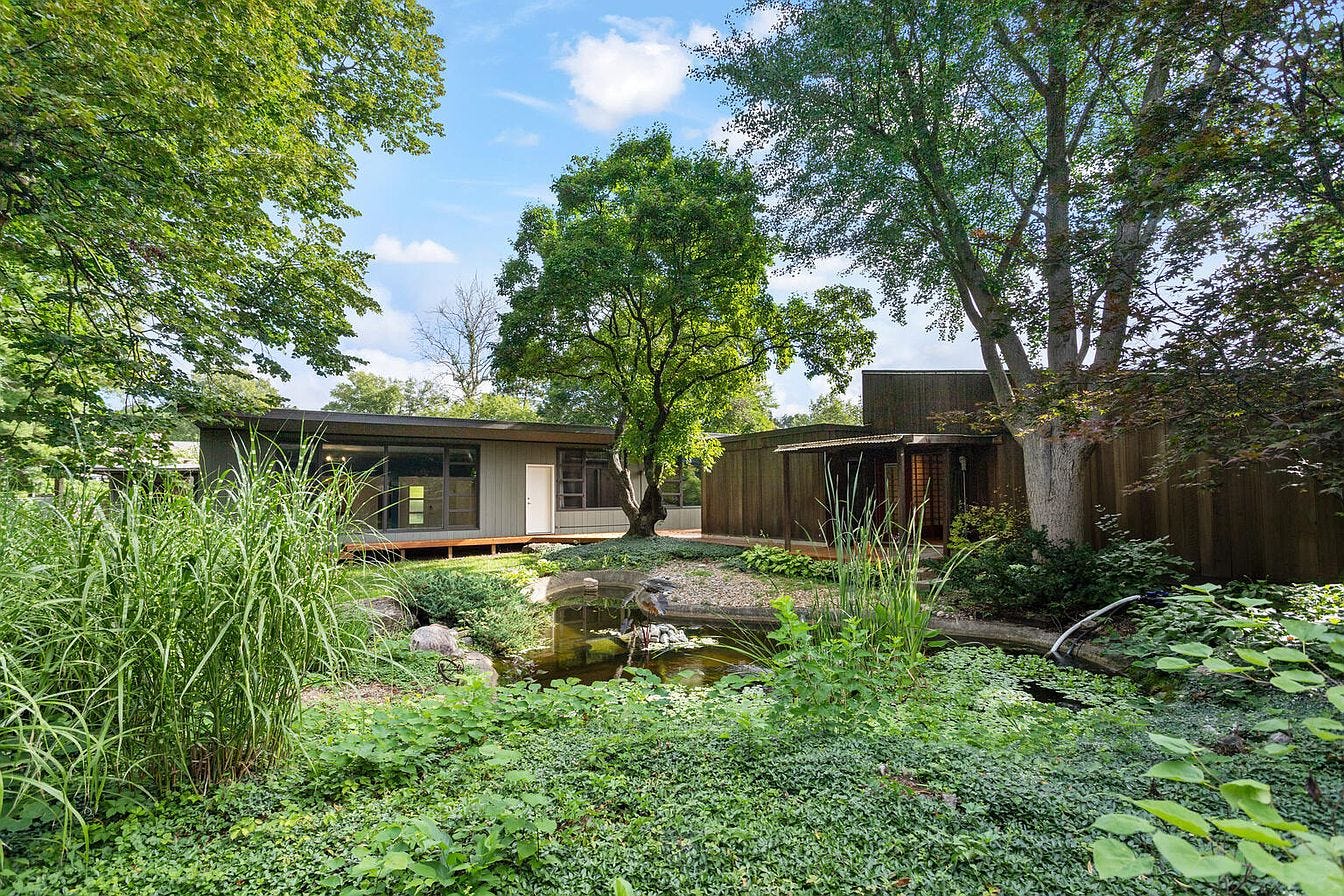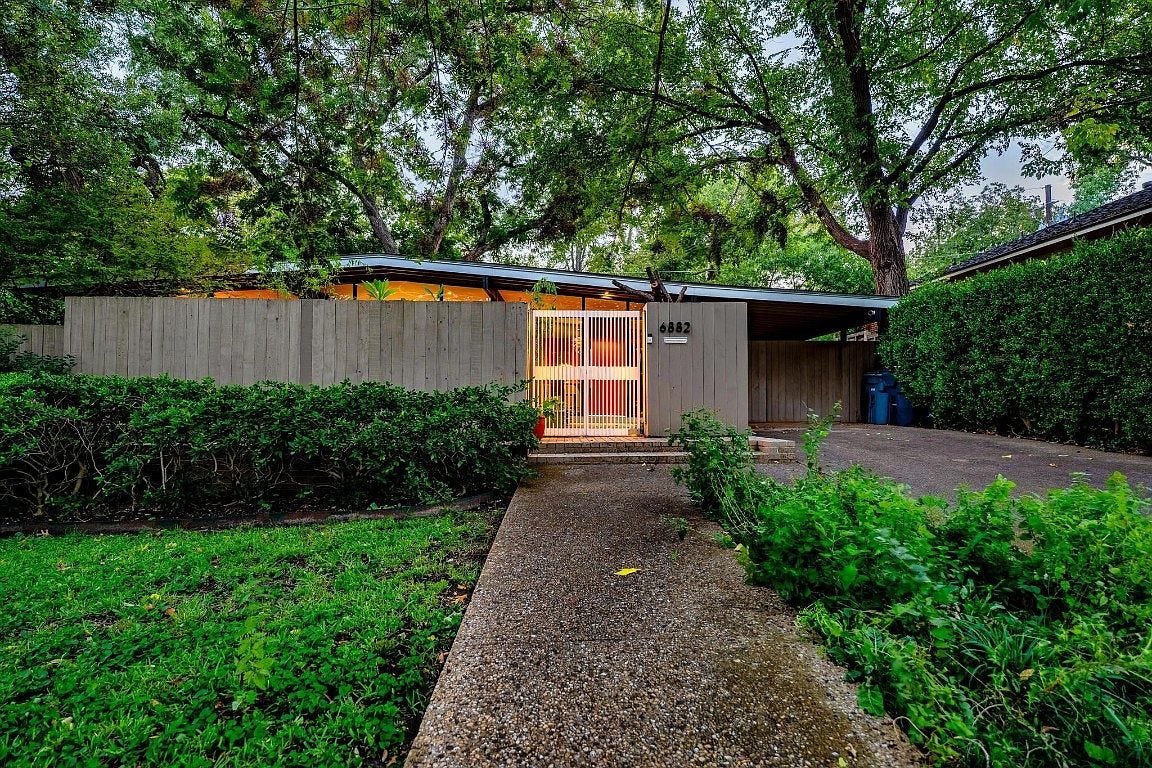Art + Science with Jean Prouvé
Curated Mid-Century Modern Home Listings from Across the U.S.A. 📍
Jean Prouvé (1901-1984) blurred the lines between designer, engineer, and sculptor. Born in Nancy, France, his artistic inclinations surfaced early, nurtured by his father, a prominent painter and sculptor. Of his upbringing, Prouvé noted “I was raised in a world of artists and scholars, a world which nourished my mind.”
After three years of art school in Nancy, Prouvé began his first apprenticeship with a local blacksmith, gaining hands-on experience and igniting a lifelong fascination with metalwork. This practical grounding would serve Prouvé well during his pioneering career.
Prouvé opened his own workshop around 1922, initially focusing on wrought iron furniture and decorative elements. His early pieces, like the "Chaise Inclinable," showcased his innovative approach, employing bent sheet metal for both lightness and strength. This fusion of functionality and elegance became part of his signature, evident in iconic designs like the "Standard" chair.
The Standard Chair was introduced as “Chair No. 4” in 1934. The design started with an obvious but profound technical insight; the back legs of of chair support the weight of the sitter’s upper body, bearing substantially more weight than those in the front. Accordingly, the Standard Chair uses thinner tubular steel for the front legs and larger voluminous hollow sections (transferring the primary stress to the floor) for the back legs. The profile of the back legs, formed from thin bent sheet steel, resembles an airplane wing, with the widest measurement at the point where the leg meets the seat frame – that is, where the stress is greatest. The tapered shape of the hollow section from the seat surface upwards, simultaneously defining the angle and position of the backrest. The chair was manufactured exclusively in Prouvé’s French factory for decades and is produced faithfully to original specifications by Vitra today.
As the 1930s unfolded, Prouvé's vision expanded. He collaborated with Charlotte Perriand and Pierre Jeanneret, exploring the potential of tubular steel for furniture with Le Corbusier. This period also saw the emergence of his interest in applying his metalwork knowledge to construction more broadly, including prefabricated buildings housing. Prouvé saw an opportunity to address the post-war housing shortage with affordable, efficient solutions. His significant early buildings using metal panels as curtain walls include a clubhouse at Buc Airport (1937–39) and the Maison du Peuple at Clichy, France (1938–39). Prouvé's commitment to social responsibility extended beyond housing. He actively participated in reconstruction efforts after World War II, developing temporary shelters for the displaced. He also embraced new technologies, pioneering the use of aluminum in furniture and architectural structures.
In 1938, Prouvé patented the groundbreaking axial portal frame, a self-supporting metal structure that could be easily assembled and disassembled. This innovation formed the basis for his groundbreaking prefabricated homes, such as the “Maison démontable 6x6” and the “Maison Tropicale.” These houses, utilizing corrugated sheet metal and standardized components, were not only practical and affordable but also remarkably adaptable to diverse climates and terrains.
In 1954, Prouvé designed a home for his family, utilizing components constructed in his workshop (Ateliers Jean Prouvé). Lovingly known as the “Maison Prouvé,” the home was constructed on a large wooded hillside overlooking the designer’s hometown of Nancy. Most of the material for the home was of course steel, with some aluminum and walls made from wood for a cozier feeling interior. Prouvé designed a number of custom furniture pieces for the home including a custom bed and desk for his daughter and a flexible shelving system that integrated directly into sections of the house. The home served the family well and was sold to the city of Nancy and the Musée des Beaux-Arts after the designer’s passing in 1984.




Throughout his career, Prouvé remained unwavering in his pursuit of functional beauty. He saw no inherent contradiction between industrial materials and aesthetic appeal, believing that true innovation lay in marrying art and science. This philosophy resonates in his timeless furniture pieces, still sought after by collectors for their sculptural forms and enduring quality.
Prouvé's influence extends far beyond the realm of design. His prefabricated homes offered a glimpse into a future where architecture prioritizes sustainability and adaptability. His innovative use of materials and construction techniques continues to inspire contemporary architects and designers today.
GEMS FOR SALE THIS WEEK
462 Mount Merino Rd, Hudson, NY 12534
Scenic 6 Sw Of Ocean, Carmel By The Sea, CA 93921
1204 Alta Paseo, Burbank, CA 91501
233 N Helena Cir, Palm Springs, CA 92262
1188 E Adobe Way, Palm Springs, CA 92262
4230 N Via Raposa, Tucson, AZ 85718
24 Homan Rd, Stanfordville, NY 12581
988 Noyac Path, Water Mill, NY 11976
5113 Lowell St, Overland Park, KS 66202
137 Atkins Ave, Shreveport, LA 71104
W876 Oak View Court, Brodhead, WI 53520
17445 Louise St, Southfield, MI 48075
3411 Valley Dr, Midland, MI 48640
4200 Berkshire Ct, Midland, MI 48640
12 Beaver Point Park, Asheville, NC 28804
5207 Indian Springs Ave, Northport, AL 35473
3857 Cromwell Dr, Mountain Brk, AL 35243
21 Greencroft Dr, Champaign, IL 61821
321 Brown Trl, Hurst, TX 76053
6882 Avalon Ave, Dallas, TX 75214



























